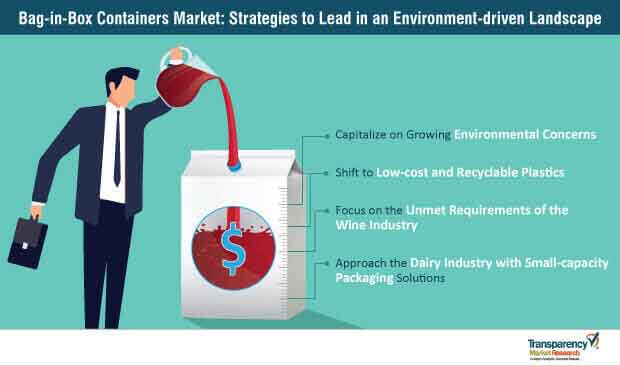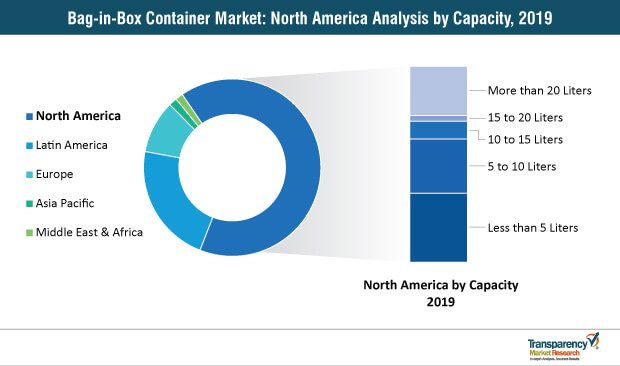
The packaging industry has had a pivotal role to play in environmental remediation activities, especially since the rise of the e-Commerce industry. With governing bodies as well as consumers voicing the need for environmentally safer and sustainable packaging, a mounting number of packaging companies are probing into innovating materials and types of environmentally-friendly packaging.
Bag-in-box containers are gaining immense popularity as an apt alternative for rigid packaging solutions, which were the workhorse of the packaging industry until a few years back. Bag-in-box containers have emerged as an efficient type of packaging that enables companies reduce the carbon footprint of their businesses. Leading players in the bag-in-box containers market are leveraging this trend in product promotions and creating a new brand identity.
Sensing the palpable shift from rigid packaging to flexible packaging solutions, which is driven by increasing environmental concerns, Transparency Market Research (TMR) investigates more into the changing strategic viewpoint of market players. In its latest offering, TMR offers a deep dive into the macro and microeconomic factors striking a significant impact on the growth of the bag-in-box container market, and provides actionable insights for market players to make value-based decisions in the coming years.

Planning to lay down future strategy? Perfect your plan with our report brochure here
Food & Beverage Industry Fostering the Market with One-third Revenue Share
The packaging industry is set to touch the US$ 1 trillion mark with the widening range of its end-use industries. The increasing demand for innovative packaging solutions in the food & beverage industry has been bolstering innovation in packaging since the past decade. As the food & beverage industry remains the largest consumer of packaging solutions, increasing awareness about hygiene and demand for convenience has stroked a shift from rigid to flexible packaging.
With the food & beverage industry gravitating towards flexible packaging solutions such as bag-in-box packaging, the global market for bag-in-box containers gained momentum. In 2018, the market recorded sales of ~870 thousand tons, reaching a valuation of ~ US$ 2.9 billion. Though the demand for bag-in-box containers has spread across various end-use industries such as chemicals and cosmetics & personal care, the food & beverage industry remains the largest end user of bag-in-box containers.
An upsurge in the demand and growing availability of innovative materials have been the primary driving engines for the bag-in-box containers market. However, the emergence of cubinators—cube-shaped liquid handling packaging solutions—as an alternative to bag-in-box containers can hamper market growth. Cubinator manufacturers are entering the food & beverage space to capitalize on its increasing growth, intensifying the competition for bag-in-box container manufacturers in the landscape.
Will the Shift from Paper to Plastic in Bag-in-Box Containers End the ‘Paperboard Economy’?
Plastic is considered harmful to the environment; however, the bag-in-box containers landscape is spurning paper and paperboard materials to adopt plastic. Manufacturers’ focus on reducing the carbon footprint of their businesses, along with manufacturing costs, is mainly attributed to the shift from paper to plastic in the bag-in-box containers space.
In 2018, various types of plastics manufactured with different polymers, such as Low-density polyethylene (LDPE) and Ethylene vinyl alcohol (EVOH), accounted for one-fourth revenue share of the bag-in-box containers market. With ongoing developments in the engineered plastics industry, the adoption of plastics is expected to increase at a rapid pace in this landscape, accounting for one-third revenue share of the market, in the coming decade.
Though plastic is becoming the workhorse material for most end-use industrial verticals, paper and paperboards will remain impervious to the spread of plastic across the bag-in-box containers market in the foreseeable future. Much more paper and paperboards are recycled than plastics, consuming relatively much lesser energy. Thereby, the idea of plastics completely replacing paper and paperboards in bag-in-box containers is still unworkable, and manufacturers will continue to build their strategies based on employing a combination of both the materials in this landscape.

Want to know the obstructions to your company’s growth in future? Request a PDF sample here
Deep Dive into the Competitive Landscape of the Bag-in-Box Containers Market
The bag-in-box containers market is moderately fragmented, and lucrative opportunities in the packaging industry are expected to boost the number of new players entering this market. Top companies in the bag-in-box containers landscape, including Smurfit Kappa Group, DS Smith, Liqui-Box, Scholle IPN, Amcor Limited, CDF Corporation, TPS Rental Systems Ltd., and Optopack Ltd., cumulatively account for ~ 45% of the total revenue share in the market.
Read TMR Research Methodology at: https://www.transparencymarketresearch.com/methodology.html
Leading players in this landscape are competing on innovation and expansion in plastic packaging facilities as well as upgrading their manufacturing technologies to maintain their stronghold in the market. For example, in January 2019, Smurfit Kappa launched a new high-speed, triple head, and automatic filling machine that can fill up to 45 3-liter packs of bag-in-box containers per minute. In March 2019, Liqui-Box announced that it would acquire DS Smith’s plastic division to upscale its position in the flexible and rigid packaging industry.
Other competitors in the bag-in-box containers market are adopting strategies to capitalize on the increasing growth of the wine industry by introducing more efficient and safer packaging solutions. The wine industry has been voicing the need for hygienic and high-standard packaging solutions for improving the shelf life of bag-in-box wine, and this will continue to have a significant impact on the upcoming strategies of emerging players in the market. In addition, profitable sales opportunities in the dairy industry and juice industry are expected to create new avenues of growth for new entrants in the bag-in-box containers landscape.
Read Our Latest Press Release:
- https://www.prnewswire.com/news-releases/affordability-and-beneficial-properties-to-serve-as-vital-growth-factors-for-construction-tape-market-during-forecast-period-of-2020-2030-tmr-301221294.html
- https://www.prnewswire.com/news-releases/global-higher-education-solutions-market-to-thrive-on-growing-popularity-of-cloud-computing-and-high-consumption-of-digital-content-tmr-301219732.html





